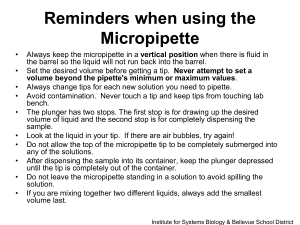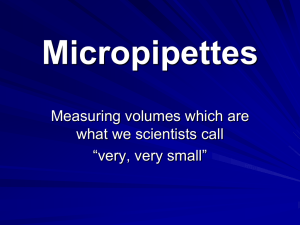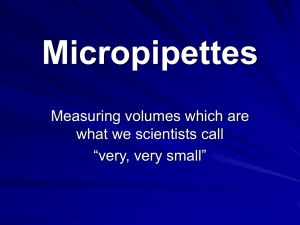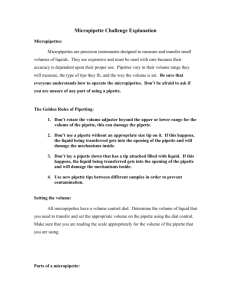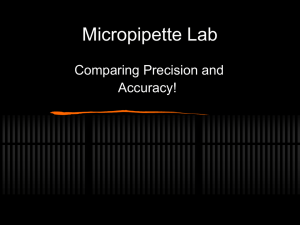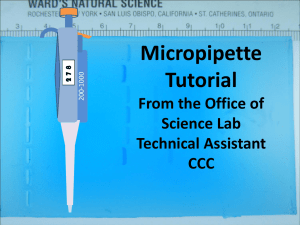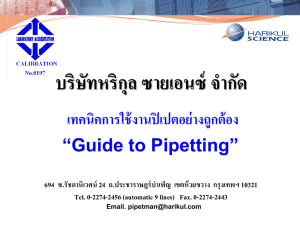آزمايشگاه ايمونولوژي
advertisement
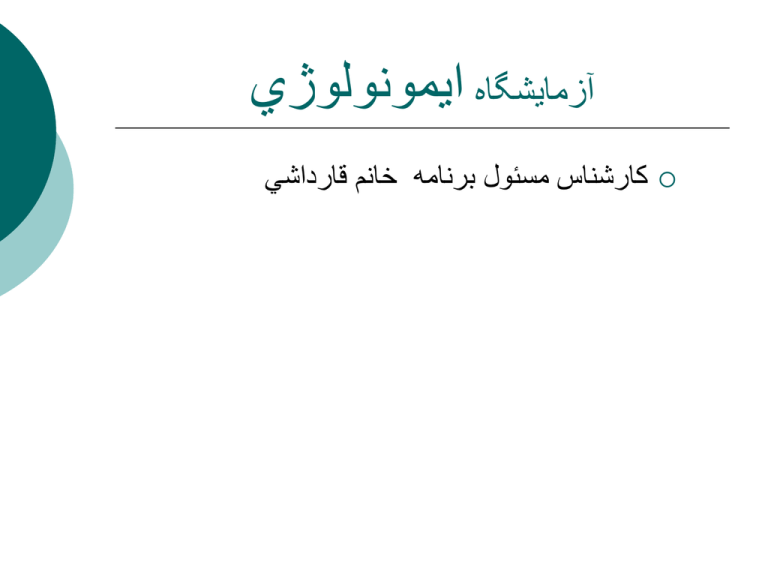
آزمايشگاه ايمونولوژي كارشناس مسئول برنامه خانم قارداشي كاربرد ايمونولوژي درمان تشخيص تحقيق پيش گيري چرا من بعنوان يك پزشك بايد ايمونولوژي عملي بدانم روشهاي مختلف آزمايشگاهي را كه مي توان آناليت ها را اندازه گيري كرد بشناسيد از محدوديت هاي كار در آزمايشگاه آگاه باشيد پشت صحنه اعداد و ارقامي كه در مطب بدستتان مي رسد با خبر باشيد منابع خطا را بشناسيد بدانيد تا چه ميزان بايد به روشها و جوابها اعتماد كنيد Errors Requesting appropriate tests Writing prescription Reading prescription Sample collection Sampling times environmental factors Drug interferences Patient identification Sample transfer Technician errors Instrumental errors Method limitations Data entry mistakes Interpretation of results How can we trust Lab Equipment Safety & Sterilization Beakers hold and/or heat solids or liquids that will not release gases when reacted, or are unlikely to splatter if stirred. Beaker Very poor item to measure volume with (+/- 5% error!) Note the total size capacity = 250 mL (upper mark is 200 mL) There are six sizes of beakers in your lab table for you to use: 50, 100, 150, 250, 400, & 600 mL Beaker Tongs Beaker tongs are used to hold and move beakers containing hot liquids. Note the rubber coating to improve grip on the glass beaker - do not hold these in a burner flame. Erlenmeyer Flask Erlenmeyer flasks hold and/or heat solids or liquids that may release gases during a reaction, or that are likely to splatter if stirred. Note the size = 125 mL Florence Flask Rarely used in first year chemistry, it is used for the mixing of chemicals. The narrow neck prevents splash exposure. Also called round-bottom flasks Flask Tongs Flask tongs are used only to handle flasks – use beaker tongs for beakers. A graduated cylinder is used to measure volumes of liquids; probably your best everyday measuring tool, there are three sizes in your desk: 10, 50 and 100 mL *NOT to be used for heating or mixing chemicals Note the rubber “bumpers”. Graduated Cylinder Some graduated cylinders that are smaller may not have “bumpers”, but have reinforced glass rims. The top plastic bumper ALWAYS stays at the top, to prevent breakage if it falls over. Reading the Volume 10 mL has approx 6.62 mL 100 mL 52.7 mL 25 mL has 11.5 mL Test Tube – we commonly use 2 sizes: 18 x 150 mm Larger tube (25 x 200 mm) sometimes used x 100the mm The size is determined by the diameter13 across top and the length of the test tube. Example: 13 mm x 100 mm (diameter) (length) Test tubes are used to mix chemicals, and also used to heat chemicals in. Test Tube Holder A test tube holder is useful for holding a test tube which is too hot to handle with your hands. Knowing where to hold this piece of equipment is Holding it here will keep your hand as far as possible from the fire, and prevent you from important. squeezing the holder and dropping the tube. Stopper Rubber and cork stoppers are used to close test tubes and flasks, thus avoiding spillage or contamination. Containers should NEVER be heated when there is a stopper in place – pressure will build up, and an explosion could occur. Test Tube Rack Test tubes can be placed upside down on these pegs for drying. Test tube racks are for holding, drying, and organizing test tubes in a vertical position, and are located in the side wall cabinets. Test tube brushes are used to clean test tubes and graduated cylinders. Test Tube Brush Small test tube brush Caution: Forcing a large brush into a small test tube will often break the tube. Don’t worry about drying the inside of a tube or cylinder - Let them air dry instead of forcing a paper towel down inside. Large test tube brush TYPES OF PIPETTES •Volumetric •Measuring •Mohr •Serological Precision & Accuracy VOLUMETRIC PIPETTES Used to deliver a single specific volume of liquid, usually between 1 and 100 ml. Shaped like rolling pins with a large belly, one blunt end, the neck, and one tapering end, the tip. MOHR AND SEROLOGICAL PIPETTES Measuring pipettes are divided into: MOHR PIPETTES the graduations on these always end before the tip SEROLOGICAL PIPETTES the graduation marks continue to the tip Examine pipettes A and B. Which is the serological and which is the Mohr? 5 in 1/10 ml TD 20oC BLOW OUT PIPETTES The frosted band should not be confused with thicker colored rings or colored dots, which are a manufacturer’s code for the maximum volume of the pipette. Remember, only blowout a serological pipette if it has a frosted band or two thin rings. HANDLING STERILE PIPETTES HANDLING AND DISPOSING OF PIPETTES Chipped and cracked pipettes should be replaced as they are unsafe and may affect the accuracy of measurements. NEVER mouth pipette. Hold the pipette by the upper third of the tube and keep the tip from touching anything. OTHER PIPETTE TYPES Transfer of uncalibrated volumes up to 2.5 ml can be accomplished using glass “transfer” or “Pasteur” pipettes shown below. These may be sterilized before use. Roughly calibrated volumes of 1 and 2 ml can be transferred with the one piece plastic transfer pipettes which may be purchased as sterile or nonsterile units. TRANSFERRING A PRECISE VOLUME OF LIQUID To produce a vacuum for aspiration, squeeze valve “A” with your thumb and index finger of one hand while using your other hand to squeeze the bulb. “A” stands for “air” or “aspirate.” (Click on the picture to see a movie on the SLC computer) To “pull” the liquid up into the pipette place the pipette into the liquid and squeeze the “S” or “suction” valve until the liquid reaches the desired level. Touch the tip of the pipette to the side of the vessel containing the liquid to remove any adhering drops. To “expel” the liquid, squeeze the “ E” valve. This will allow the liquid to flow out of the pipette except for the last drop. If the last drop of liquid that remains in the tip must be expelled, squeeze valve “E” with your thumb and forefinger, cover the opening in the small bulb with your middle finger and squeeze the small bulb. Use and Maintenance of Micro-pipettes Parts of the Pipette Pipette tips Operating the Micropipette Step 1: Set the Volume Pipettors – 3 Volumes: Digital Volume Indicator: Volume Adjustment Knob: Operating the Micropipette Step 1: (Continued) Read the Volume How to Read the Volume Indicator: (a): P-20 Model 6.86 m l = 0.00686 or 6.86 x 10-3 ml (b): P-200 Model 132.4 m l = 0.1324 or 1.324 x 10-1 ml (c): P-1000 Model 262 m l= 0.262 or 2.62 x 10-1 ml Operating the Micropipette Step 2: Attach the Disposable Tip Example of tip sizes: Attaching the disposable tip Operating the Micropipette Step 3: Depress the Plunger to the First Stop Step 4: Immerse Tip in Sample Step 5: Draw up the sample To aspirate the sample into the tip, allow the pushbutton to return slowly and smoothly to the fully extended UP POSITION. NEVER LET THE PLUNGER SNAP UP! This draws the exact calibrated volume into the tip if the tip remains below the liquid surface during withdrawal. Step 6: Pause Wait a few seconds to ensure that the full volume of sample is drawn into the plastic tip. WAIT LONGER FOR LARGER VOLUMES. WAIT LONGER FOR MORE VISCOUS ("SYRUPLIKE") SUBSTANCES. Operating the Micropipette Step 7: Withdraw the Tip Remove the tip from the sample liquid. No liquid should remain on the OUTSIDE of the tip. Wipe away any droplets on the outside of the tip with a lint-free tissue, such as KIMWIPES, but only wipe droplets from the side of the tip. NEVER TOUCH THE TIP OPENING or you may absorb part of your sample. Proper Droplet Removal WRONG Droplet Removal Operating the Micropipette Step 8: Dispense the Sample To dispense the sample from the pipette: a) Touch the tip end to the side wall of the receiving vessel and b) Depress the plunger to the FIRST STOP. c) Pause for at least one second-- 1-2 seconds for P-1000, 2-3 seconds for P-5000, or longer for viscous liquids. d) Press the plunger to the SECOND STOP (the second point, of greater resistance, at the bottom of the stroke) to expel any residual liquid in the tip (like "blowing out" a glass pipette). (a) Start Dispensing (b) 1st Stop = (c) 2nd Stop = Dispense Expel Operating the Micropipette Step 9: Withdraw the Pipette With the plunger fully depressed, withdraw the pipet from the receiving vessel carefully, sliding the tip along the wall of the vessel. Holding the tip against the side of vessel is especially important when transferring small volumes of liquid. Step 10: Release the Plunger Gently allow the plunger to return to the UP position. DO NOT allow it to SPRING BACK! Step 11: Discard the Tip Discard the tip by depressing the tip ejector button, as shown below. A fresh tip should be used for each sample to prevent sample carryover. Press ejector button to discard tip. Practice with Pipette Review material • and practice using a pipette Use proper • pipetting techniques Equipment and Supplies • 3 automatic pipettes • Several capped sample vials • Green sample solution to practice volume transfer Accuracy and Precision Accuracy means the closeness with which the • dispensed volume approximates the volume set on the pipette Accuracy is specified as mean error, the average • deviation of replicate measurements from the expected set volume Precision is the "scatter" or reproducibility of • individual measurements of the same volume Precision can also be expressed as standard • deviation Accuracy and Precision (Continued) Relative accuracies are generally about • 1% or less Precision is less than 0.5 % except when • transferring the smallest recommended volume for a given pipette model Using the pipettes to transfer volumes • which are below the recommended range will introduce larger errors Pippetting Guidelines and Precautions For optimal reproducibility, use the following pipetting procedures: (1) Consistent SPEED and SMOOTHNESS when you press and release the PLUNGER (2) Consistent pressure on the PLUNGER at the FIRST STOP (3) Consistent and sufficient IMMERSION DEPTH (4) Nearly VERTICAL POSITIONING of pipette (5) AVOID ALL AIR BUBBLES: Since the plastic pipette shaft can be damaged if liquids are drawn beyond the tip into the shaft (6) NEVER lay the pipette on its SIDE nor INVERT the pipette if liquid is in the tip Practice with Pipettes Practice using the pipette • Practice setting a few volumes • Practice reading the digits of set • volumes Practice drawing up and dispensing • samples Get the "feel" of the 1st and 2nd • stops Practice "blowing out" the pipette • Relative sensitivities of tests (approx) Usual operating range [Ab] or [Ag] precipitation immunoelectrophoresis double/radial diffusion immunofluorescence 10 mg/ml - 1 mg/ml 0.1 - 10 mg/ml ELISA (colour) (chemiluminescence) 0.1 - 10 ng/ml 0.01 - 10 ng/ml radioimmunoassay 0.01 - 10 ng/ml CALCULATING THE RATES A test is used in 50 people with disease and 50 people without. These are the results: Disease Test + - + - 48 3 51 2 47 49 50 50 100 Disease Test + - + 48 3 51 - 2 47 49 50 50 100 Sensitivity = 48/50 = 96% Specificity = 47/50 = 94% Positive predictive value = 48/51 = 94% Negative predictive value = 47/49 = 96%
